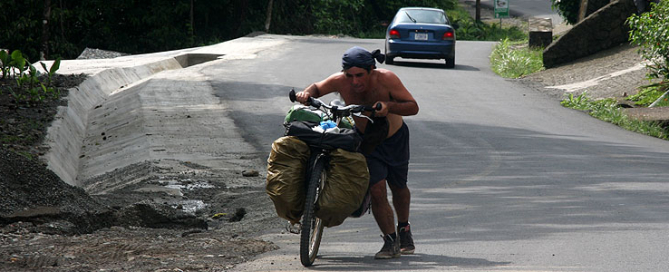Myths and realities of the Latin American tour, by Juan Longo
Exciting and promising is the idea of swimming in that turquoise sea that is the Mexican Caribbean. Palms, bodies shaped by who-knows-what deity, ancestral ruins of cultures that sought harmony with the environment, magic volcanoes, birds, butterflies, etc.
I am awakened back to reality when I hear on the speakerphone the announcement of the departure of a flight to some country.
I find myself anchored to the Tecuman airport in Panama City, waiting for the company’s authorities to let us get on board, as they claim a departure document is required from the destination country, in this case Colombia (this chunk of the continent, the “Darién Gap”, can only be traveled by ship or air). Arbitrarily, in their logics, the power in command stipulates the operations, and so the legality or not so much, and the irregularities, are all subject to the whim of whoever interprets the canon, the sacred laws of the aero-spatial market in this case.
Once and again, an image of the philosopher Michel Foucault comes to mind, with his power relationships, musings about who makes the law and regulations who decide the freedom of a traveler. I wonder how many Salvadorians are equivalent to a Swiss one. In the European balance, surely 3 Spaniards amount to one Swedish one. In the Latin American balance, 3 Peruvians can almost amount to 2.5 Chileans. I wonder all this because the place of birth determines the ease or hardship to cross a border. I come out of the lethargy of these chaotic thoughts and I remember the reason and events of the trip.
I started my bicycle trip in Tulum, Mexico, with two great travelers: Fran Camara and Pablo Garcia.
I met Fran in Puerto Escondido, Mexico, during the Christmas season, selling crafts. I met Pablo a day before starting the demented travel of touring this part of the planet.
Whoever hears stories about traveling the world by bike, may feel tempted to embark in such a marvellous experience, but something is always missing in these dreams: the hardships of the highway, physical pain, heat, thirst, and those huge bodies called mountains, which rise in the distance and must be crossed.
First stage of the trip: survival
A very important theme to take into account: you have to travel with money or know how to make some, in our case. As travelers, the visa that countries give us is as a tourist, and so we enter already bordering illegality. Working in the street when public space is regulated can be complicated because of the police, Immigration authorities or municipal inspectors, or the other craftsmen and vendors. Let’s just say that the primal territoriality prevails many times when seeking resources. But what never fails is the generosity of those who support us every step of the way.

On the highway we start plotting where to sleep, and the need to find a safe place arises. Central America has an important feature, its rural areas. When approaching a hacienda or farm, land workers always show solidarity. Places to let us stay can be varied in these villages: churches, schools, homes, or last case, waiting after sunset we can sneak into a road and set camp, as our hunter-collector ancestors did, but in post modern times.
Why set out to a bicycle trip? What idea led to this? What are the dreams to go after?
In my case, nothing particular. It was a personal bet to toughen up and let go of some fears I had been carrying for years.
I am a jeweller and an explorer of the art world, understanding that the manifestation of an art piece is personal firstly, and a humble contribution to the world next. And so strolling by diversity was a great source of learning.
Antigua City and Tikal ruins, cultural patrimony of humankind and of its de-humanization.
“Not everything that is allowed is honest” Seneca.
There is a perverse relationship between the need to generate resources through tourism and the displacement towards the outskirts by the original population.
I tried to get to Tikal with Fran. Tikal is one of the most important archaeological cities of the Mayan world. We tried to find out if there would be a back road to go through without paying the 20-dollar entrance fee, but we hit a wall 18 Km before the ruins; it is impossible to sneak in through a crevice, due to a great amount of forest custodians around.
We stayed by the door, watching how tens of trucks drove by full of tourists. I protested to one of the forest rangers about the price of the entrance fee and asked how come we don’t all have free access if it’s patrimony of humankind. He looks at me and says that that’s the only way, one has to pay. I wonder what the Mayans would think. Because beyond the impressive architecture of the temples, the place is more like a shopping center bought out by private enterprises. Neither is the money collected given out to the region, but it is “federalized” towards Guatemala’s prosperity.
We then notice that Tikal is not the ruins themselves, but the stories of the workers and vendors that are outside of the park, who tell us how the division of the land happened and the problems with the property rights, the difficulties of field workers and the tragedy they were part of in the last war. The name “Tikal” comes from the Mayan word Ti, which means place, and kal, which means voices. And so we simply listened what they had to tell us.

Antigua city, colonial, tidy and aseptic, is ready to avoid informal vendors’ work and not allow for them to make a simple crumb from the foreign owners who have purchased the majority of properties, ejecting the cultural owners of the city with extortions. In these places one doesn’t hear a lot of native languages but English, one more symptom of the cultural imposition that remains in the indigenous America. Of course, in parallel with the trouble with the law and hindrances to work freely, the Guatemalans are formidably generous.
Belize-Salvador-Honduras: poverty, insecurity, violence and migration to the American dream
“In the depths there’s no roots, there’s what’s been torn,” Hugo Mujica.
When leaving Mexico we had been warned about how dangerous is was to cross Belize, due to the “maras”. The same thing happened in Belize heading to Guatemala, and with every other country until we reached Nicaragua. I heard real stories of people who received me and told me about the murder of a relative, and I could see war guns being carried to guard a bicycle shop in a city in El Salvador or the gang-related curfews.
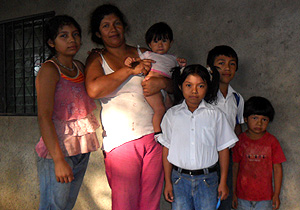
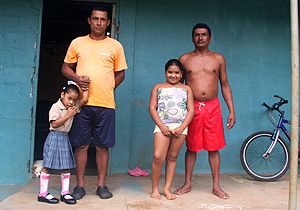
Who generates this violence? What is the origin? This entry is not an in-depth essay on the drama of Central America, but if we use our good sense and think of the 4.5 dollars that a field worker makes to live on for one day, the everlasting intromission of the United States, the wild repression that these countries suffered in the last 70 years, it is not hard to find the tip of the iceberg.
Without exception, everyone we asked has a relative who is in the USA or who tried and will continue attempting to cross to the USA. It is the Mecca to solve the problem of extreme poverty and have hope. That is, if they can cross the border and work in any McDonald’s for 7.5 dollars an hour. As a migrant would say: “so far from God and so close to oblivion”.
Nicaragua: neo Sandinism and foreign investments
“We have failed over the sandbanks of rationalism, let’s step back and touch again the abrupt rock of mystery” Urs von Balthasar.
The landscape changed dramatically after crossing the border from Honduras to Nicaragua; not only its topography but its infrastructure, its people’s predisposition and their awareness as a nation.
This is a country in growth. After the long war took the lives of 150,000 Nicaraguans, today’s generations only want to live in peace.
We arrived in Nicaragua to work during Easter, in the beautiful city of Granada, of colonial architecture, among volcanoes and by the lake’s shoreline; we were at a point where none of us knew well where we would head next in Central America.
Touring its routes was exciting and we had the feeling that something was coming to its end. For love reasons, Fran departed to Costa Rica and Pablo to Mexico.
I traveled solo towards San Juan del Sur, in the Pacific Coast, to try my luck and make some money that I needed to cross Costa Rica and Panama.
Selling on the streets I was approached by a Panamanian who worked for an American production company. He was interested in my jewellery work and soon after invited me to join the artistic staff for the reality show Survival.
The facilities where their scenography, woodworking, painting and sculpture workshops were set up were all extraterritorial, with private security and internal dispositions. The feeling among workers and artists was one of fraternity, where smiles and good vibrations were part of the discipline.
I lasted only a day and a half in that job, after I learned that they intended to pay me the “national” salary (2 USD/hour), and not the “international” one, where there’s an abysmal difference between both. Of course these kind of shows are always carried out in countries as the Philippines, Indonesia or any other where they can exploit people. I say it bluntly, as they are a marine vanguard of television, so that millions of people sit and watch an adventure show in faraway paradises and forget for a while the failures of their lives.
Costa Rica and Panama, epilogue and farewell
“To lament your own existence is like preventing your own development, denying your own experience is like sealing with a lie the lips of your own life” Oscar Wilde.
Costa Rica, different from the rest of Central America, disappears its fieldwork as one sees its beautiful landscapes sport For Sale ads, starting at USD 160,000. With an extremely high cost of living, national parks and tourism everywhere, this is a country where tons of people would like to visit and live in. Pablo and I continued the trip together. We stayed at places that Pablo had previously contacted, also at the Red Cross, and some other times we camped with nature. It was the first country in this trip where in a rural setting a hacienda owner told us that we couldn’t spend the night on his field, quite the scene. We went by this country rushing, because the rain season was walking on our toes.
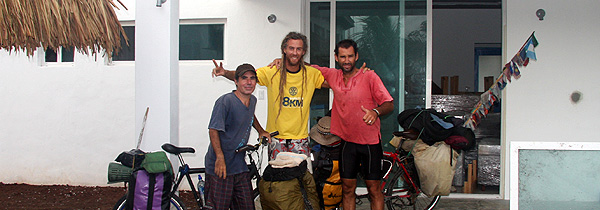
Welcome to Panama: but only if you have the USD 500.00 in hand to show in the Migration office that you are “solvent.” I consider it a neutral country, like those powder soaps that make no foam. You can see some prosperity, public works on highway construction, better wages that in the rest of Central America, heat, very high humidity and, something I couldn’t fail to mention: in the 450 km we toured, there was not a single meter of highway, be it jungle or cities, clear of road garbage like plastic bags, diapers, soda cans; this was antipodean of the extremely clean Costa Rica.
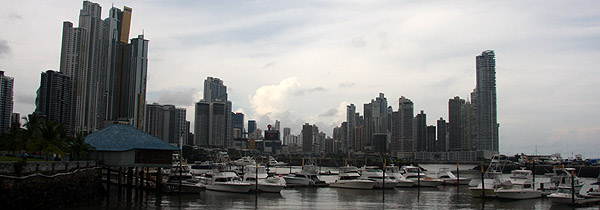
We arrived in Panama City, which pretends to be Miami, Hong Kong or Malaysia with its modern buildings with nonsensical shapes. What else? Foreign workers at duty to take home dollars. Dollar is the official currency, and also the Balboa, paradoxically a Spanish colonizer, and foreign currency to reaffirm their monetary sovereignty, it’s all a mystery.
Traveling is useful to learn about everything that is different, to learn that you need less that what you think you should need, to value the basic needs where money has no power because there’s nowhere to spend it, to learn the simple life, without ambition but with a moving cogency, to know that countries, borders and flags are conventions that deep down try to separate people complicating their freedom.
Try as travelers, take a leap and go into the other side…
Time to ship again, Pablo is calling. Once more, the man resolves.
Greetings to everyone who tries to bring respect, beauty, and harmony to this conflictive, diverse and wonderful world every day.
Juan Longo.


